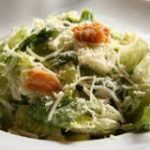Who Doesn’t Love A Good Centenary?

Cesare "Caesar" Cardini
I notify you of this a week in advance so you have time to prepare. To gather the ingredients, to deck the halls. But to celebrate what? Let's think of all the things that happened in 1924.
In January, Ramsay Macdonald became the UK's first ever Labour Prime Minister (though he got a right tanking in the General Election in October); Eric Liddell of Chariots of Fire fame won his famous Olympic gold medal; so too did the GB curling team in the first ever Winter Olympic Games.
To which I say, pah and pshaw! At a recent centenary service for Liddell, half of the choir had no idea who he was, never even having heard of the film. But they will almost certainly have eaten today's dish which was created by happenstance on 5 July 1924. In the United States, Prohibition was barely one third of the way through. It did little for the morality of the average American, (the justification used by the politicians who passed the law) but it did serve to make fortunes for many, not all illegal.
An enterprising Italian named Cesare Cardini, along with his brother Alessandro, set up a hotel in Tijuana, Mexico. This was some 150 miles south of Los Angeles, a mere hop, skip and a jump if you had your own plane. Many wealthy Americans would make the trip south for a riotous weekend. Presumably the drink-flying laws were a thing of the future. The Cardinis' business boomed.
 So much so that after the Fourth of July celebrations of 1924, the kitchen was very low on essential supplies. They had lettuce: they had bread, Parmesan, eggs, olive oil, lemon juice and Worcester sauce. And, most importantly of all, they had the inventive mind of Cesare. The man would have done well on Ready, Steady, Cook. The resulting salad was a huge hit with diners, many of whom were regulars.
So much so that after the Fourth of July celebrations of 1924, the kitchen was very low on essential supplies. They had lettuce: they had bread, Parmesan, eggs, olive oil, lemon juice and Worcester sauce. And, most importantly of all, they had the inventive mind of Cesare. The man would have done well on Ready, Steady, Cook. The resulting salad was a huge hit with diners, many of whom were regulars.
On their next visit, many ordered it off menu, and the dish, originally known as Aviator Salad, took off from there. (I'll spare you any further puns, such as the kitchen being in a flap. There may be more - think of them for yourselves). With typical flamboyance, Cardini took to preparing it table side. As its fame grew, it took the name Caesar Salad (easier on the tongue than Cesare's Salad) and spread to Hollywood, then to New York. Wallis Simpson, later to become the Duchess of Windsor, is credited with introducing it to Europe.
It was originally a side dish, typically eaten with the fingers and the Romaine leaves left whole. Now it's often available as a main dish with chicken, prawns or whatever. I have the feeling that Signor Cardini wouldn't mind at all. Diners are happy, and his name lives on.
How to make it? You'll have to read Friday's Tom Cooks! Though if you are planning on buying in the ingredients, we will call for Romaine lettuce (though you can get away with Cos, Little Gem, or even iceberg.) Relatively few recipes these days will call for Worcester sauce. But what is the main ingredient in Worcester sauce? Anchovies. And what do you get if you emulsify eggs and olive oil? Mayonnaise, of course. Do you have jar of Hellmann's handy? If you are a cheat, it may be to your advantage.
Bear in mind that the original was purely a salad. These days it's probabaly most commonly served as a main course, often featuring chicken. We'll look at that another day.
Tom. I am sure romaine and cos are the same variety. I think the supermarkets started calling it romaine a few years ago presumably as it sounds more exotic.
Well, well, so they are. My researches tell me that Romaine was the US name, where we in the UK favoured cos. Apparently the Romans discovered it on the Greek island of Kos. The inexorable spread of Ammericanisaation strikes again. Every day’s a school day. Thanks, Pat.